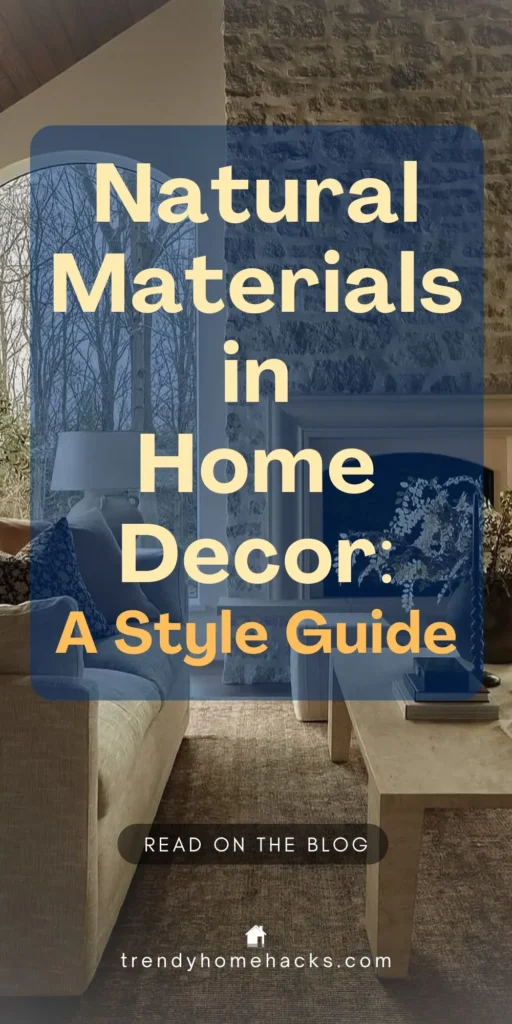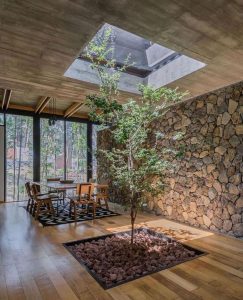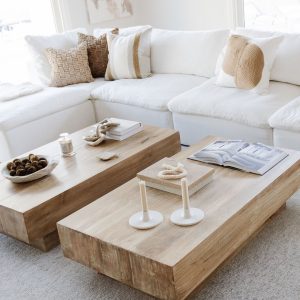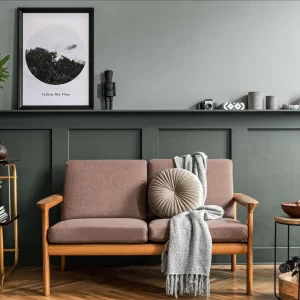There’s something about natural materials in home decor that just feels right. It’s in the way a worn wood floor creaks underfoot, or how a linen pillow softens with time and use. These aren’t just design choices—they’re reminders. Of slow mornings, windows cracked open, the scent of something baking. Of homes that are lived in and loved on.
When we bring nature indoors—wood, stone, woven textures, even just a bundle of dried herbs—we’re doing more than decorating. We’re grounding our spaces. We’re creating a kind of quiet that invites us to breathe a little deeper.
This isn’t about chasing a look. It’s about choosing things that last. Things that feel true. Your home might be full of pattern and color. Or it might lean toward the simple and spare. There’s room for the natural either way. This guide is here to walk with you—style by style, texture by texture—as you find the materials that speak to your space, and your story.
The Timeless Appeal of Natural Materials
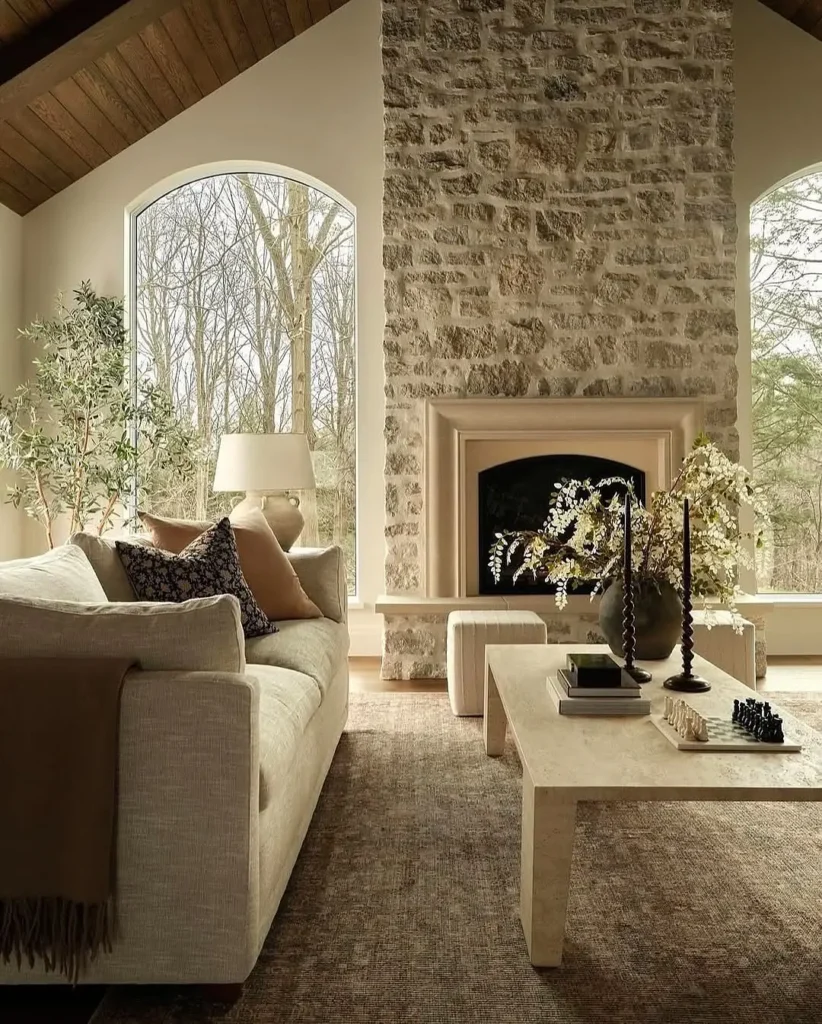
Some things just don’t go out of style. A weathered oak table passed down through generations. A wool throw that’s seen winters come and go. The soft scratch of jute beneath bare feet. These are the pieces that carry a quiet kind of beauty—not loud or flashy, just steady and sure.
Natural materials have a quiet way of making a home feel settled—like it’s been cared for, not just styled. Maybe it’s because they age alongside us, softening and settling in over time. Or maybe it’s the way they connect us—reminding us of places we’ve been, or hope to go. A stone tile might call to mind your grandmother’s kitchen. A rattan chair might bring back the feeling of slow summer afternoons, shaded and still, on a porch where the breeze always found its way in.
There’s also something grounding about these materials. In a world of fast fixes and endless options, they offer simplicity. If you’ve ever noticed how raw textures can ease a space—and quiet your mind—you’ll find more inspiration for bringing a sense of calm into your home through natural elements.
They bring warmth and balance, even when everything else is in motion—that’s their quiet power. Natural elements don’t just fill a space. They shape how it feels. They give it heart.
Essential Natural Materials to Know
When it comes to decorating with nature, it helps to get to know the materials themselves—their texture, their tone, and the feeling they bring into a room. Each one has its own story to tell.
Wood
Wood is at the heart of many well-loved homes. There’s an easy comfort in the grain of wood—whether it’s the soft wear of reclaimed barnwood, the sculpted edge of a handmade table, or the clean stretch of white oak floors. Lighter woods feel soft and airy, while darker tones like walnut or mahogany bring richness and depth. Used in large or small ways, wood always adds warmth. For a charming DIY touch, try repurposing wooden crates for rustic storage or display.
Stone
There’s something grounding about stone. Marble adds quiet elegance. Soapstone brings depth. Slate and travertine feel aged in the best way. Whether used for countertops, fireplaces, or accent tables, stone invites a slow, steady rhythm into a space.
Natural Textiles
Think linen that softens over time, or a wool throw that’s always within reach. Cotton, flax, jute, and hemp are breathable, beautiful, and functional. These fibers don’t just look good—they feel like home. And if your style leans clean-lined but grounded, explore how to decorate your organic modern home with earthy textures.
Earthy Accents
Clay pots, terracotta tiles, and hand-thrown ceramics offer more than color—they carry the imprint of the hands that made them. Cane and rattan add lightness and movement, especially when paired with wood or stone. If you’re drawn to woven textures with a relaxed, earthy feel, take a look at these rattan decor ideas that bring texture and warmth into your home.
Botanicals & Leather
Sometimes the simplest touches say the most. A bundle of dried lavender. A few stems of olive branch. A leather ottoman that softens over time. These details layer life into your home. And if you love bringing the outdoors in, you might enjoy making a seasonal wreath with natural materials and subtle scent.
Natural Materials in Different Design Styles
There’s no single way to bring nature indoors. That’s the beauty of it. Whether your home is all clean lines or filled with found treasures, natural materials have a way of meeting you where you are. They adapt. They soften. They settle in. Here’s how they show up—and shine—across a few favorite styles.
Modern Farmhouse
Walk into a modern farmhouse, and you’ll likely be greeted by warmth that doesn’t try too hard. Exposed wood beams overhead. A stone fireplace that anchors the room. Open shelving with pottery that’s been used and loved. Natural elements here serve a purpose—they’re practical, lived-in, and often carry a story. Reclaimed wood, iron lighting, worn leather, cotton throws, and soft linen drapery are the backbone of this style. For simple, soul-filled ideas, here are easy ways to bring natural elements into your home without breaking the budget.
Organic Modern
This style is all about balance—natural but polished, minimal but inviting. You’ll see simple silhouettes paired with textured fabric, hand-formed ceramics resting on raw wood, and neutrals warmed by jute, clay, or a touch of pottery. It’s a quiet mix of modern form and organic feel. If this speaks to your style, explore ways to layer earthy elements into an organic modern space.
Scandinavian
There’s a quiet joy in Scandinavian homes—where everything has a purpose, but nothing feels cold. Pale woods like birch or white oak keep things light, while wool, leather, and linen bring in warmth without heaviness. The palette is soft and pared back: creams, greys, and earthy neutrals. Every element has space to breathe. If you’re drawn to this kind of gentle simplicity, you’ll enjoy these ideas for warming up a Scandinavian bedroom with natural wood.
Minimalist
Minimalist homes may seem bare at first glance—but the best ones are rich in detail you can feel. A matte ceramic vase. A walnut bench with clean lines. Polished concrete floors that reflect soft afternoon light. These spaces aren’t about removing personality—they’re about letting a few materials speak for themselves. If your style is simple but soulful, you might like this guide on bringing natural texture into your living room.
Bohemian
Boho spaces don’t follow rules—they collect moments. A handwoven rug picked up on a trip. A rattan daybed layered with cushions. Jute poufs, macramé hangings, oversized plants. It’s all about texture, pattern, and soul. Natural materials are the thread that ties it all together—giving the style depth without fuss. If you’re styling a relaxed, sun-kissed space, explore these rattan furniture pieces that bring easy summer charm into boho decor.
French Country
French Country style welcomes imperfection in the most elegant way. Think limestone floors, timeworn oak tables, handwoven baskets, and breezy linen curtains. Everything feels collected, not curated. Natural materials here are soft and romantic—used in ways that are both practical and beautiful. A stone sink, a distressed wood armoire, a bundle of lavender on the windowsill. It’s a look that values charm and character over polish, making nature feel right at home.
Traditional
There’s comfort in the familiar. Traditional homes often feature timeless materials—solid wood floors, crown molding, wool area rugs, and heavy linen or velvet drapes. Stone fireplaces and carved wood furniture ground the room. These materials don’t shout. They stay steady over time. If you’re thinking about first impressions, consider adding a solid wood front door that bridges classic and contemporary styles.
Coastal
Coastal style isn’t just about blue and white—it’s about ease. Woods worn by time, seagrass underfoot, cotton that gives easily, and rattan that lightens a room—all of it brings a bit of the outside in. The palette is soft and sun-faded, with sandy tones and sky-colored accents. Light and air move freely here. For ideas that lean breezy but grounded, take a peek at these rattan touches that add coastal charm to everyday spaces.
Rustic / Cabin-Inspired
Step inside a rustic home, and the materials do most of the talking. Thick wood beams. Stone walls. Leather that’s aged just enough. These spaces feel collected from the land itself. There’s a tactile richness to it all—wool blankets, iron hardware, raw-edge tables. It’s cozy, not cluttered. If you love this kind of wilderness-meets-welcome, consider adding a touch of rugged charm with natural wood stump tables.
How to Mix Natural Materials Thoughtfully
Layering is often the first step to bringing natural elements into your home. Think of it like a conversation between textures. Woven jute beside soft linen. Smooth stone near worn wood. Each material has its own feel, and when they’re paired with care, the room takes on a kind of quiet depth.
Start with one material that speaks to you. Maybe it’s oak, with its golden warmth. Or maybe it’s clay—simple, unglazed, and earthy. Let that be the anchor, then build around it with layered textures: rough with smooth, matte with soft sheen, cool with warm.
And don’t be afraid of imperfections. A table with a few knots in the wood. A handmade bowl that’s not quite symmetrical. It’s those quiet imperfections—the ones you barely notice—that end up making a house feel like home.
If your style leans more edited—like organic modern or minimalist—texture carries more weight. In those spaces, natural surfaces do the heavy lifting. You’ll find thoughtful ways to begin in this guide to bringing natural texture into your living room.
However you mix them, let the materials do what they do best—bring honesty, warmth, and a little bit of the outdoors in.
Tips for Sourcing and Styling
There’s something special about choosing pieces that already carry a bit of history—or at least feel like they do. A woven basket found at a flea market. A handmade bowl from a local maker. A piece of reclaimed wood, worn smooth from years of use. When it comes to natural materials, it’s often the source that gives the piece its soul. If baskets feel like a good place to begin, here are creative ways to use woven baskets in your home decor.
Start with vintage or secondhand
Old furniture, baskets, textiles, and pottery often have more character than something brand-new. Look for pieces with honest wear—faded linen, softened edges, or patina that tells a story. They’re not flaws, they’re the fingerprints of life well lived.
Support small and handmade
Artisans, local shops, and independent brands are often your best bet for true, natural beauty. These makers usually choose materials with care—clay, wood, stone, fiber—and shape them in ways machines can’t.
Let the material lead
Instead of styling around a theme, let the material guide you. Let a rattan bench anchor a quiet corner, balance a shelf with weathered driftwood, or build a table setting around hand-thrown pottery. These natural elements will do most of the work if you let them.
Don’t over-polish
Often, the most thoughtful thing you can do is take a step back and let the piece speak for itself. Let the wood breathe. Let the linen wrinkle. Let the clay be a little uneven. Perfection isn’t the goal here—presence is.
If you’re just getting started, don’t overthink it. Start small. A basket here, a wood stool there. Let the space come together slowly, with pieces that speak to you and stories that find their way in.
Final Reflections
Bringing natural materials into your home isn’t about following a formula—it’s about creating a space that feels honest, layered, and true to you. Whether it starts with a basket, a beam, or a single linen pillow, every small choice adds warmth and meaning.
And if you’re drawn to the idea of designing with intention, you might also enjoy exploring how to style your organic modern home with natural elements. It’s a natural next step for blending beauty with purpose.
Let your home evolve with time. Let it reflect the rhythm of your life. The textures, the tones, the materials—they’ll do the rest.
Frequently Asked Questions about Natural Materials in Home Decor
Can I mix natural materials with modern furniture?
Absolutely. In fact, natural materials can soften modern lines and make a space feel more welcoming. A sleek sofa paired with a rattan accent chair. A stone coffee table surrounded by simple, upholstered pieces. These small contrasts create balance—and help the space feel lived-in rather than styled.
What style works best with natural wood?
Natural wood works beautifully across many styles, from farmhouse and Scandinavian to traditional and organic modern. The key is choosing the right finish—lighter tones for airy spaces, darker woods for rich, grounded rooms. Let the grain and texture of the wood guide the way, and the style will follow.
What’s the difference between natural and organic materials in decor?
The term ‘natural’ typically describes materials sourced directly from the earth—like wood, stone, linen, or clay. “Organic” usually means they’re grown or processed without chemicals. So a wool rug is natural, but if it’s labeled organic, it means the wool came from sheep raised without synthetic inputs. Both bring warmth, but organic materials offer an added layer of sustainability.
How can I use contrast to highlight natural materials in a neutral space?
Contrast doesn’t have to mean bold. In a neutral space, you can highlight natural materials by playing with texture—pairing a smooth stone counter with a woven shade, or a linen slipcover with a leather accent chair. These shifts in finish and feel create subtle, beautiful tension.
What are the best finishes to preserve the beauty of raw wood and stone?
Look for finishes that protect without masking the material. For wood, oils and hard waxes allow the grain to show through. For stone, sealants with a matte or honed finish keep the surface breathable and natural-looking. Avoid overly glossy coatings—they often compete with the material instead of honoring it.
Enjoyed Natural Materials in Home Decor? Be sure to pin it for easy access later!
